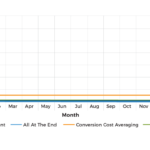Historically, financial advisors didn't actually have much control on the prices they charged clients, as financial plans were compensated by the products implemented pursuant to the plan... and the commission payout rates on those products were set by the product manufacturers (insurance companies or asset managers) with payouts controlled by broker-dealers and insurance agencies. It's only been in recent years, with the rise of the Registered Investment Adviser, where RIAs can actually control and set their own AUM and financial planning fees, that suddenly advisors must actually figure out if their AUM, hourly, retainer, or other pricing model is "competitive" to the marketplace and appropriate given the services they provide!
In this week’s #OfficeHours with @MichaelKitces, my Tuesday 1PM EST broadcast via Periscope, we explore how to determine if you have the "right" pricing for your services by tracking your prospect conversion rates, why your fees should be too expensive for at least some of your prospects, and why there is such thing as having "too high" of a close rate with prospects!
Though the marketplace has increasingly converged on the "common" price point of a 1% AUM fee, when it comes to fee-for-service financial planning (e.g., hourly, standalone projects, and retainer fees), it's hard to look at what other advisors are charging, because there aren't many advisors doing fee-for-service planning in the first place, and we're all so varied in the services that we do provide, that it's difficult to compare anyway. Some advisors will back into a price based on the income they desire and the time (billable hours) they can put into the business. Others will price based on the perceived value to the client. But another approach still is to look at what your clients (or really, prospects who become clients) are willing to pay, based on what they actually decide to pay (or not) in hiring you!
The key metric to track to understand whether your financial planning fees are priced appropriately is your prospect conversion rate – i.e., how many of your prospects become clients. Notably, this doesn't include leads who were not "qualified" (e.g., those who do not meet your asset or other fee minimums), because it's really about how many people who are qualified to work with you ultimately choose to do so. Thus, if you meet with 15 prospects, of which 10 are qualified, and 3 of them do business with you, your conversion rate is 30% (which is 3 out of 10 qualified prospects). And this number matters because it's a direct statement about whether your value proposition is being perceived as worthwhile by your prospects. Simply put – if your pricing is compelling, you tend to have a pretty high close rate!
In this context, you can think about prospect conversion rates in four tiers: Tier 1 (<25%), Tier 2 (25-50%), Tier 3 (50-75%), and Tier 4 (>75%). For those in Tier 1 (<25% conversion rate), there is a real problem; it may be that your pricing is too high for your value proposition (a pricing problem), or it could be that you're not doing a good job conveying your value proposition (a sales problem), but something needs to be changed. Tier 2 (25-50% conversion rate) is where most advisors are, and the fact that you've gotten to at least a 25% conversion rate is evidence your pricing is reasonable. The caveat, though, is that many advisors in this category don't feel very good about their conversion rate (since more than half of people you talk to are telling you "No"), but the reality is that your pricing can't be that far off if 25% of people are telling you "Yes", so the key here is to focus on improving sales skills to boost this conversion rate (but don't cut your pricing to grow faster, since your fees are reasonable!).
When it comes to Tier 3 (50-75% conversion rate) advisors, there are really two types. The first is an advisor with some kind of recognized niche or specialization. This type of advisor is arguably in the conversion rate "sweet spot", as it is virtually impossible to get everyone to do business with you, but the majority of prospects really are hiring you and demonstrating they see value relative to your fees. However, the second type of advisor in this category is an advisor who was a Tier 2 advisor, but rather than refining their marketing or sales process, simply cut their fees to increase their conversion rate. This type of Tier 3 advisor is in a problematic long-term situation, as pricing aggressively low just means you are eventually going to have trouble being able to afford to hire more staff and scale your business.
The final category of advisors, Tier 4 advisors (>75% conversion rate), can also be surprisingly problematic. Most advisors who close "virtually all" of their prospects are proud of it, but my advice for advisors in this category is to raise your fees! Because, in practice, the reality for these advisors is that if clients are this happy with your pricing, they'll probably still be pretty happy with a higher price... and an increase in fees should boost revenue from clients who are willing to pay more far more than it will reduce revenue from a few more clients who might say no. Which means these advisors can end up making more money (as higher fees more than offset the slight reduction in new clients) but doing less work (because there are fewer new clients!) if they adjust their pricing.
Ultimately, though, the key point is to recognize that your prospect conversion rate is an important metric for determining whether you are priced properly. And if you aren't keeping track of this metric, it only takes three numbers to keep track going forward: the number of leads you get, the number of qualified prospects amongst those leads, and the number of those prospects that turn into clients. From those numbers, you'll be able to tell if you are pricing your services appropriately, and, if you need to make some adjustments, what those adjustments might be!






 Welcome, everyone! Welcome to the 67th episode of the Financial Advisor Success Podcast!
Welcome, everyone! Welcome to the 67th episode of the Financial Advisor Success Podcast!



